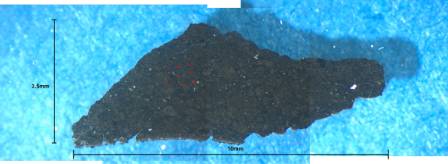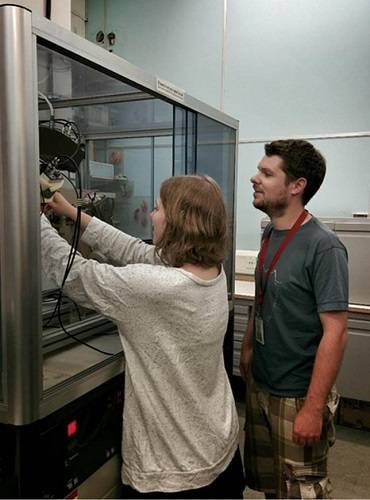A guest post by Helena Bates, undergraduate student at Imperial College London.
This summer I had the opportunity to work alongside scientists in the Mineral and Planetary Science Division at the Natural History Museum on a project sponsored by the Paneth Trust, a scheme which offers bursaries to undergraduates so that they can do a summer internship in fields relating to meteoritics.
The project I joined was led by Ashley King and involved investigating minerals that were created by aqueous alteration in CI and CM carbonaceous chondrites. These types of meteorites have had almost all of their original material altered by water into fine-grained clay type minerals, which are so small they cannot be easily studied by looking through a microscope. Instead, we used a process called X-ray diffraction to identify mineral components. When a small beam of X-rays is focused on the sample it produces a diffraction-pattern unique to the minerals present.
Ashley and I are busy using the X-ray diffractometer.
Usually this process involves grinding up a sample of a meteorite, and any information about where in the meteorite a certain mineral is located is lost. However, the alteration that the meteorite experienced was probably not uniform so knowledge of the distribution of aqueous alteration minerals is important. If we can see where the alteration took place within the meteorite this can help us put constraints on the role of water in the early solar system and perhaps even see how the water moved through the sample! So rather than grinding up samples we carried out X-ray diffraction on thin sections of meteorites.
We looked at a total of 4 meteorites, all of which were found in Antarctica and on loan to us from NASA and JAXA. They were; Y-82162, a CI chondrite, LAP 02277 and MIL 07689, both of which were CM1 chondrites, and MCY 05231, a CM1/2.
 A thin section of meteorite LAP 02277 with dots showing where X-ray diffraction patterns were collected.
A thin section of meteorite LAP 02277 with dots showing where X-ray diffraction patterns were collected.
For each meteorite we produced maps of various minerals that are produced by reactions with water, including phyllosilicates, iron oxides and carbonates. These maps give us spatial information about where some minerals are located in relation to others. Obviously this is just the beginning of the technique, but it is easy to see how this can be taken further to produce larger maps which can show how water moved through the sample. This will help us understand the role of water during the formation of asteroids, 4.6 billion years ago.
Thank you so much to everyone at the Natural History Museum, especially Ashley King, who let me help with his research, and thank you to the Paneth Trust for helping fund this internship – it was an incredible experience!



